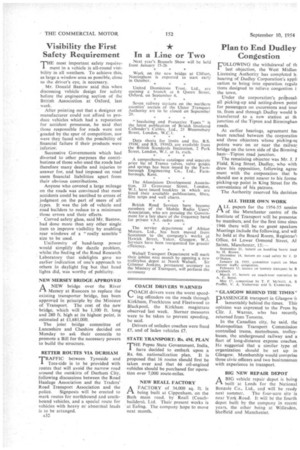. •.•
Page 34

If you've noticed an error in this article please click here to report it so we can fix it.
V tsibility the First
Safety Requirement
THE most important safety require' ment in a vehicle is all-round visibility in all weathers. To achieve this, as large a window area as possible, close to the driver's eye, is necessary.
Mr. Donald Bastow said this when discussing vehicle design for safety before the .engineering section of the British Association at oxford, last week.
After pointing out that a designer or manufacturer could not afford to produce vehicles which had a reputation for accident proneness, he said that those responsible for roads were not goaded by the spur of competition, nor were they faced with the possibility of financial failure if their products were . inferior.
Successive Governments which had diverted to other purposes the contributions of those who used the roads had therefore many deaths and injuries to answer for, and had imposed on road users financial liabilities apart from their obvious contributions.
Anyone who covered a large mileage on the roads was convinced that most accidents could be ascribed to errors of judgment on the part of users of all types. It was the job of vehicle and road builders to reduce to a minimum those errors and their effects.
Curved safety glass, said Mr. Bastow, had done more than any other single item to improve visibility by enabling rear windows of a "really sensible" size to be used.
Uniformity of head-lamp power would simplify the dazzle problem, whilst the finding of the Road Research Laboratory that sidelights gave no earlier indication of one's approach to others in daylight fog but that head lights did, was worthy of publicity.
NEW MERSEY BRIDGE APPROVED
ANEW bridge over the River Mersey at Runcorn to replace the existing transporter bridge, has been approved in principle by the Minister of Transport. The cost of the new bridge, which will be 1,100 ft. long and 280 ft. high at its highest point, is estimated at £1,681,000.
The joint bridge committee of Lancashire and Cheshire decided on Monday to . ask their councils to promote a Bill for the necessary powers to build the structure.
BETTER ROUTES VIA DURHAM TRAFFIC between Tyneside and Tees-side is to be provided with routes that will avoid the narrow road around the outskirts of Durham City, following discussions between the Road Haulage Association and the Traders' Road Transport Association and the
police. Signposts will be erected to mark routes for northbound and southbound vehicles, and a special route for vehicles with heavy or abnormal loads is to be arranged.
COACH DRIVERS WARNED COACH drivers were the worst speeding offenders on the roads through Kirkham, Freekleton and Fleetwood to Blackpool, the Kirkham magistrate observed last week. Sterner measures were to be taken to prevent speeding, he said.
Drivers of unladen coaches were fined £5, and of laden vehicles £7.
STATE TRANSPORT: Rs. 4M. PLAN THE Pepsu State Government, India, have decided to embark upon a
Rs. 4m. nationalization plan, It is proposed that 16 routes should first be taken over and that 66 oil-engined -vehicles should be purchased for operation over 7,000 route-miles.
NEW REALL FACTORY
AFACTORY of 34,000 sq. ft. is being built at Cippenham, on the Bath main road, by Reall (Coachbuilders), Ltd. Their present works is at Ealing. The company hope to move next month.




















































































